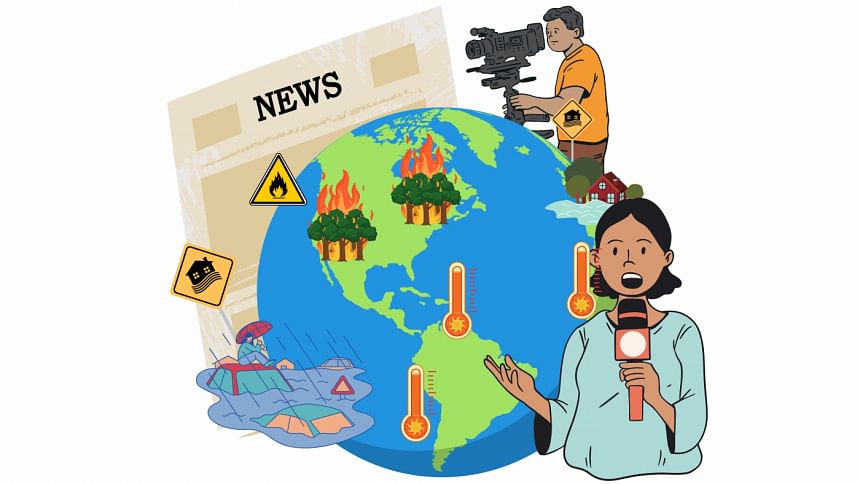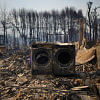Why climate journalism is vital for Bangladesh

In recent years, the impacts of climate change have reshaped our world in countless ways. Bangladesh, a nation highly vulnerable to climate-related risks, has experienced profound disruptions to our way of life. Climate journalists report and communicate these transformative changes in our daily lives.
But what exactly does "climate journalism" mean, and what role does it play?
Climate journalists are tasked with reporting on a world where the reality of climate change is undeniable, so their work revolves around documenting the far-reaching consequences of environmental shifts and their intersection with human societies. They document a wide range of topics, including sustainability, biodiversity, natural disasters, renewable energies, environmental policies, initiatives. Their coverage spans a broad spectrum of issues related to climate change and its implications.
The field of climate journalism has seen a surge in popularity in recent years, and prominent newspapers have added a dedicated "Climate" section to their publication. This is a crucial addition for any news outlet, as climate journalists play a vital role in educating their audience about the profound impacts of climate change on our lives and what actions we can take to tackle it.
Climate journalism is not just reporting about the grim issues that we are facing daily, but also reporting on the resilient stories that can inspire people to take climate actions. For instance, The New York Times recently published a report that shares the coping strategies adopted by Bangladesh to tackle the water-crises and how it can be a lesson for other countries. The article titled "Here's a Look at the Water Crises That Might Be Coming to You Soon" takes us on a journey to the district of Gopalganj, and shares a hopeful story of one floating vegetable garden owner, Shakti Kirtanya.
The report says that, due to the rising risks of climate change induced flooding in various regions, the practice of floating gardens, such as those in Gopalganj, is increasing. In response to this, the government has provided support for the establishment of floating gardens in 24 out of Bangladesh's 64 districts over the past five years.
Although Bangladeshi journalists are already on the ground covering the environmental impacts of climate change, certain challenges persist, such as limited resources, lack of training, and risks associated with reporting on climate-related issues. One such hurdle that reporters face is the lack of training when it comes to climate storytelling, as newsrooms don't specifically train reporters when it comes to such issues.
In response to these challenges, newsrooms worldwide are establishing new standards and practices for covering climate change, aiming to ensure more accurate and comprehensive documentation. Effectively communicating the complexities of climate change to the audience is crucial, and both the newsroom and the reporters bear the responsibility for achieving this.
The Earth Journalism Network, Covering Climate Now, and the Society of Environmental Journalists are among the journalism organisations that provide valuable resources for training climate reporters. These organisations offer resource guides designed to equip climate journalists with the necessary tools to enhance their coverage.
Some of these guides include "Reporting from the UN Treaty COPs and Other Climate and Environmental Conferences: Tips for Journalists, from Journalists," "Reporting on Coastal Resilience: A Resource Guide for African Journalists," "How to Use Maps Effectively in Climate and Environmental Journalism," and more. These guides serve as invaluable training materials for journalists, equipping them with the skills needed to tackle challenging climate stories.
Climate journalism plays a key role in influencing policy decisions, as policymakers rely on the information and insights provided by climate reporters. It is crucial that our climate reporting actively contributes to the development of policies aimed at mitigating the impacts of climate change.
To ensure comprehensive coverage of the unfolding climate situation, it is crucial for newsrooms in Bangladesh to develop their own resource guides and conduct training workshops for their journalists. By doing so, they will be aligning with current industry standards and practices, enabling them to effectively document the complexities of climate change in Bangladesh.
The significance of this journalism field is growing. In the next decade, climate change is going to substantially transform our lives. By delivering accurate and compelling narratives, climate journalists have the power to shape policy discussions and drive meaningful action towards climate resilience and sustainability. Their work serves as a catalyst for ensuring that policies effectively address the challenges posed by climate change.
Usraat Fahmidah is a high school graduate.

 For all latest news, follow The Daily Star's Google News channel.
For all latest news, follow The Daily Star's Google News channel. 








Comments